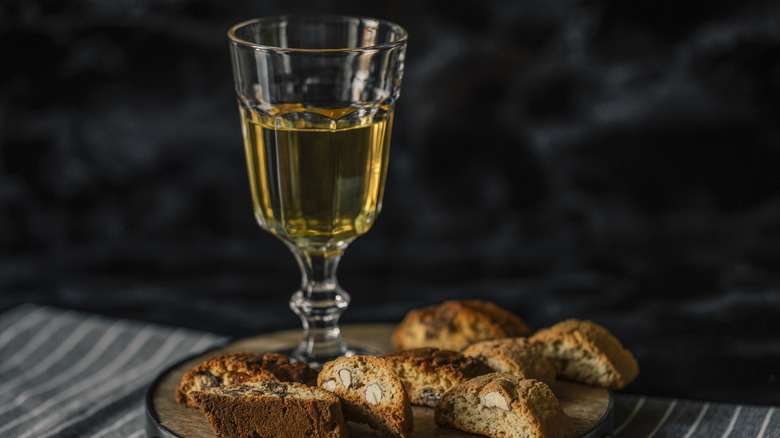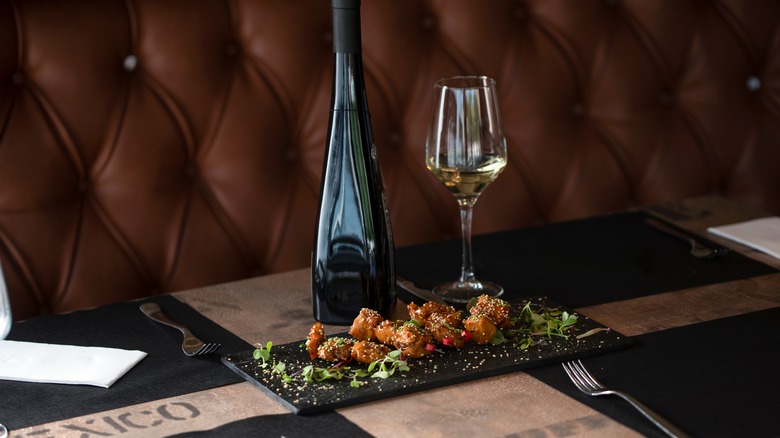Chef Massimo Bottura Thinks Dessert Wine Deserves A Bigger Place At The Table
Dessert wine doesn't have to be relegated to the end of your meal. This isn't a cheeky go-ahead to have dessert before your dinner — though, you know, go ahead; life is short and adulthood has to have some perks. This is the okay to have dessert wine with your meal. In an interview with Food & Wine, Chef Massimo Bottura says so.
It's controversial and against much of the wine-pairing advice out there. Dessert wines, naturally, have a reputation for being served with, or for, dessert. The conventional wisdom is that a sweeter wine can blow out your palate and unbalance the savory meal. But Bottura thinks this isn't necessarily always true. The exact phrasing he used, actually, was, "This is crazy!"
If you've ever had fruit in a savory dish, like cherries over duck or apples with pork, you know that sweet things can — at times — make the dish. Bottura reminisces about a dinner he served at a wedding: shaved white truffles over tortellini in a fresh cream sauce, paired with a Sauternes. It was so good, he found himself standing in the kitchen at midnight after a wedding — with Beyoncé, Jay-Z, and the CEO of Moët Hennessy – Louis Vuitton — having seconds (everyone has stories like this, right?). The takeaway: Like any wine, the key to pairing is in matching richness. A cheese-filled pasta covered in coveted white truffles and cream can stand up to a dessert wine. It's decadent. That's the secret.
What is a dessert wine?
Dessert wines are big experiences. That's why they're so often paired with or served as dessert. They come in small glasses and get sipped like good whiskey. They're made from grapes that have gone through a little more on the vine than standard wines, making them more concentrated and intense. Sometimes that's over-ripening, sometimes that's a freeze-cycle, sometimes it's on-the-vine inoculation with a beneficial fungus called Botrytis Cinerea (Noble Rot to its friends), like with Massimo Bottura's favorite Sauternes. Some are harvested but then left to "raisinate" before winemaking, a process called passito. Sometimes it's fortified with a spirit like brandy during fermentation, which stops it from fermenting and leaves residual sugar but gives it a boost in ABV.
There are, generally speaking, five styles of dessert wine: sparkling, lightly sweet, richly sweet, sweet red, and fortified. Any wine that is off-dry or sweeter, meaning it contains 6 or more grams of sugar per liter, can fall into one of these categories, but most people consider dessert wines to be sweet wines, containing 21 grams of sugar per liter or more.
Pairing dessert wines with savory food
Like any wine pairing exercise, dessert wine should be paired with food based on shared flavors and shared intensity. With a table wine, intensity usually means alcohol content or tannin structure as well as boldness of flavor. In dessert wines, it means sweetness and viscosity of body as well as boldness of flavor. You shouldn't pair a rich, deep red Port with fish tacos, but you could easily serve it with a peppered steak and blue cheese sauce. They're bold flavors with a rich, creamy mouthfeel. They're both decadent.
Lightly sweet wines pair well with spicy food. With its notes of lychee and rose petals, try a sweeter Gewurztraminer with spicy Thai and Vietnamese food. Pair a sweeter Riesling with pork or sausages. A sweet Viognier, with its mango, tangerine, rose, and honeysuckle notes, could pair with Indian or Iranian food — or for a decadent meal like a butter-poached lobster.
Richly sweet wines pair well with rich flavors; that's why Massimo Bottura chose a Sauternes to go with his cream and white truffle tortellini. A rich porchetta or prime rib wrapped around rich, funky cheese and herbs comes to mind. Just remember the key to balance: fat, salt, acid, and sugar. Then, experiment with what tastes good to you.


